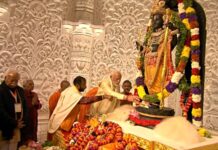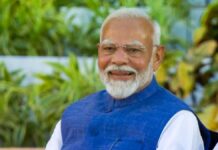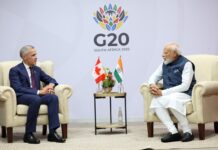
During their winter break, a group of Harvard stu-dents and professors traveled to India to witness the Kumbh Mela, which has been widely described as the largest human gathering on Earth.
Wandering among a crowd of Hindu devotees and sadhus, or holy men, the students were there to research and observe the temporary mega city that had popped up along the banks of the Ganges to house the millions of festival attendees.
For Brenna McDuffie, a sophomore majoring in South Asian Studies at Harvard, this incredible feat of urban planning and design sparks many potential research questions.
“There are hundreds of reasons to marvel at such an event. How can such a mammoth city be constructed for a one-month festival? How does such a mass gathering remain largely peaceful? Why do people keep coming to such an event? Such a gathering is definitely one of the greatest opportunities for research of all kinds,” McDuffie said.
The Harvard undergraduate students joined forces with students from across Harvard’s graduate schools, along with professors and researchers in the field, to collaborate on a project called “Mapping India’s Kumbh Mela.”
As part of its research, the group is studying the complex dynamic and environmental impact of the “pop-up mega city” that is built for the festival, replete with housing, water supply systems and electricity.
Rachel Taylor, a sophomore studying anthropology at Harvard, commented on environmental concerns associated with the festival.
“Many pilgrims hold the belief that since Mother Ganga can purify souls, she can surely handle discarded plastic bags,” Taylor said. “A major focus of this year’s Kumbh has been the health of the heavily polluted Ganges.”
While many students who find more than academics abroad do so as an individual pursuit, this interdisciplinary Harvard project to map the Kumbh Mela is based on the premise that many individual student contributions can contribute to something larger.
“It was fascinating when a big group of us would go to a sadhu’s akhara together, but would each be looking at something different. While I might be watching the singing bards as part of my research on performance, another student would be checking out the toilet facilities while yet another was taking pictures of the akhara’s alleyways and camp structure as part of a mapping project,” McDuffie said.
However, the research initiative was not a one-sided experience that benefited the students alone. In a setting far removed from the typical university classroom, professors were able to interact and engage with their students in a unique learning environment.
“I love the independence of spirit that students demonstrated. … They had a kind of fearlessness and a can-do spirit that enabled them to accomplish far more than I had imagined,” wrote Diana Eck, a professor of comparative religion and Indian studies at Harvard who was one of the faculty members leading the team.
Students share a similar admiration for the professors who worked with them.
“I became interested in a course on the Kumbh Mela last spring when Professor Diana Eck told me her hopes to offer it, and I didn’t hesitate for a moment when the opportunity to enroll arose,” Taylor said. “She is an incredible professor and person, and I knew this was truly a once in a lifetime trip.”
Now returning to campus, the work will continue as students attend debriefing sessions and prepare their research to be included on the Harvard South Asia Institute’s Kumbh Mela website.
In reflecting on her experience at the festival, McDuffie is liberal with her praise.
“There is no better place to see the scope of Indian culture, religion and tradition than at the Kumbh. From performances, to rituals, to displays of class structure and social disparity, the Kumbh has it all.”
Ishani Premaratne is a Spring 2013 USA TODAY Collegiate Correspondent.
Ishani Premaratne





